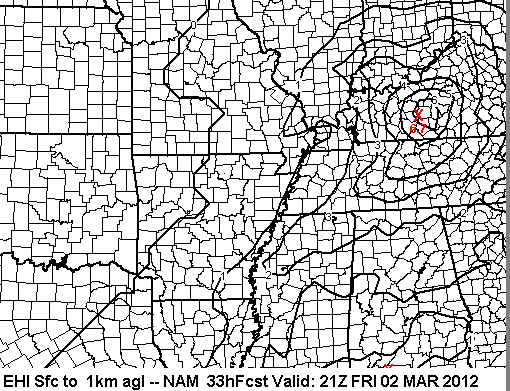Lookout for Friday, safety ideas – updated 1142 am
(Courtesy wxcaster.com and Harris)
1. Friday severe weather
Two or three times in February, the atmosphere was either capped, stopping what could have been a severe weather outbreak, or we we had favorable conditions for bad weather but no trigger for storms. Don’t let the lack of events the past 2 or 3 weeks cause you to ignore this one, especially in north Alabama.
A strong cold front will approach the eastern US, including Alabama, on Friday night (we could have a 24-hour temperature drop of 30 degrees). This time, the front will move into an unstable air mass CAPE over 1,000 and no cap. In addition, there will be quite a bit of wind shear, with winds at 5,000 feet near 55 mph, and helicity of 200-300.
The pattern is complex, so location and timing are still difficult. The largest wind shear will be to our north, and in places like Nashville and Bowling Green, the EHI may be over 5. Here, we are looking at EHI of 1 to 3…this is still significant, and the largest since Jan 23. It looks like our biggest threat for severe weather will come Friday afternoon and evening. We will likely see damaging winds, large hail, and some tornadoes, especially north of I-20. It looks rather scary in Nashville and Bowling Green.
2. Safety ideas
I am planning on publishing an extensive blog soon showing pictures I have taken in examining the damage from Apr 27, 2011 and Jan 23, 2012, comments from people who witnessed the tornadoes, and some ideas I have developed in looking at some of this. Some preliminary points:
– Have a NOAA Weather Radio with a battery backup for information in case your power goes out. And make sure you have running batteries in it!
– If a tornado warning is issued for your area, don’t wait around taking pictures and not taking shelter.
– If you do not have a basement nor an underground storm shelter, the whole “go to the interior room on the lowest floor” thing works most of the time. I’ve seen houses where the top floor was damaged severely, but the lower floor received only minor damage. I’ve also seen houses where interior rooms like bathrooms without windows or closets stay intact while the rest of the house blows away.
– Close the doors to the bathroom, closet, etc., and sit on the floor. You want as many walls between you and the tornado as possible, and smaller rooms seem stronger (closer together support I guess…it’s easier to bend a long piece of lumber than a short one).
– If you have a basement, go to the corner of it that is most underground and is away from garage doors (one of the weakest points on a house). But, don’t assume that a basement is automatic safety. If you have access to the area under your front porch and it is underground, that often works better because it puts you in a small room with multiple layers of concrete blocks around you.
– Also, in basements, get under something sturdy, like a work bench, heavy furniture, etc. Falling bricks or concrete blocks will often be slowed down or stopped by the furniture. If nothing sturdy is available, you could consider getting inside your car if it is inside the underground part of the basement and is fairly new (good roof strength, etc., according to iihs.org).
– Get helmets for everyone in your family. Many people in tornadoes are injured by flying or falling debris. Bicycle helmets are fine, batting helmets, football helmets, whatever.
– Use blankets, sofa cushions, pillows, or mattresses to protect yourself from flying glass, etc. Have something already in your safe place if you can.
– Wherever your safe place is in the home, leave a flashlight with batteries there, and know how to turn off your main electrical breaker and your gas line in case of a leak.
– The best thing to do is to have a storm shelter professionally installed.
– Have a plan that everyone in your family knows about. That way, if a tornado strikes quickly and for some reason you’re caught off guard, you can all go there fast.
These are some ideas, mostly old ones that have been around for years. But, after seeing so many totaled houses with survivors, I realize you can survive most tornadoes in most houses. The odds of an EF-4 or EF-5 hitting your house is very low in any event (even on Apr 27, 2011, only 1.1% of Alabama’s landscape was affected, and that was a once-in 40 year event). Most tornadoes are EF-0 to EF-3. But, even at EF-0, a tree can fall into your house, and rooms with exterior walls can be demolished. None of the above safety rules are foolproof, and some people get injured or worse even though they did exactly the right thing. But, following safety rules (lowest floor, small interior room, away from doors and windows, helmets, under something sturdy) will greatly improve your chances of getting through a tornado without injury.
Category: Severe Weather



















